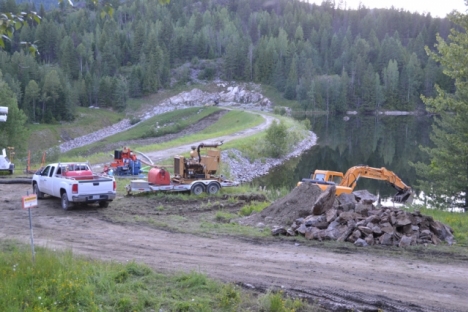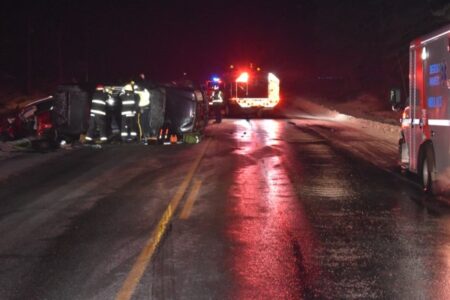Dam Safety Review holds no surprises but highlights risks
There were no surprises from the HB Mine site Dam Safety Review but there are definitely concerns to be addressed, loss of life being one of them.
“We’re well positioned to be in compliance,” said the RDCK’s resources recovery manager Mike Morrison.
The RDCK acquired HB’s tailings pond when it bought the Salmo property in 1998 for use in connection with its landfill site.
Since then, the regional district has had to undertake a number of actions to prevent contamination, and in 2012, heavy rains produced sinkholes from internal erosion that could have caused a major catastrophe if a breach had occurred.
The 147-page dam safety review — conducted every seven years — identified such areas of concern as emergency response times, potential loss of life, plausible failure modes, dam breach analysis consequences, and cost of economic recovery, in addition to hydro technical assessments.
The report submitted in May 2014, by Tetra Tech EBA in Kelowna found that overtopping, where the spillway is blocked with debris, slope instability and internal erosion were the failure modes considered to be “plausible.”
“Internal erosion would be most likely,” said Morrison. He said that the issue was corrected by the remedial work of lowering the pond level by a metre after the sinkhole discovery.
Warning time in the event of an imminent collapse was addressed in the report.
“As no permanent observers are present at the HB Dam, warning times would be less than 15 minutes for all potential causes,” the report said.
There is one residence in the flood wave zone, which covers an area almost one square kilometer, and is bisected by Highway 3. It was concluded that given the highway exposure, loss of life could be up to 3 people in the event of a collapse.
Morrison said the constant monitoring of water levels and the flow of the silty tailings would slow the flow and provide enough advanced warning to clear the area and highway.
Should a collapse occur, the report estimated it would cost between $46 and $83 million to restore the area and replace the dam.
Based on this direct economic loss, the report upgraded the “consequence classification” from significance to “very high.” This upgrade means that dam safety reviews must be conducted every five years instead of seven, if the new classification proposed is accepted by the Ministry of Mines.
Among other recommendations, the report also recommended that a feasibility study be undertaken within the year to assess the various modifications that could be made to the embankment to reduce internal erosion.
Morrison said the geotechnical assessment would be made, although the $100,000 tab has yet to be included in the budget.
He said that the RDCK has already completed several requirements as a result of the sinkhole remediation. “We are well poised, as we have already taken care of the more substantial items.”
Morrison said the Mount Polley Mine’s earth dam collapse in August that spewed millions of cubic metres of water and possibly toxic slurry into sensitive creeks and lakes some 50 km northeast of Williams Lake brought an Order from the Minister that all mines must be inspected.
As a result, “most dam owners are scrambling to have their works inspected by December,” Morrison said.
The report did not address the toxicity of contamination from the mine site. Data for 2013 is being compiled by the RDCK.
However, in August, the RDCK filed a Civil Notice of Claim against Teck Cominco, the original owner of the mine.
The essence of the claim is that the regional district has had to undertake a number of remedial actions, like spillway improvements, storm water impoundments and engineered wetlands to ensure the pond water is clean and contained behind the dam at safe levels to prevent contamination.
























Comments